Related Research Articles

A cocktail is an alcoholic mixed drink. Most commonly, a cocktail is a combination of one or more spirits mixed with other ingredients, such as juices, flavored syrups, tonic water, shrubs, and bitters. Cocktails vary widely across regions of the world, and many websites publish both original recipes and their own interpretations of older and more famous cocktails.

James Andrews Beard was an American chef, cookbook author, teacher and television personality. He pioneered television cooking shows, taught at The James Beard Cooking School in New York City and Seaside, Oregon, and lectured widely. He emphasized American cooking, prepared with fresh, wholesome, American ingredients, to a country just becoming aware of its own culinary heritage. Beard taught and mentored generations of professional chefs and food enthusiasts. He published more than twenty books, and his memory is honored by his foundation's annual James Beard Awards.
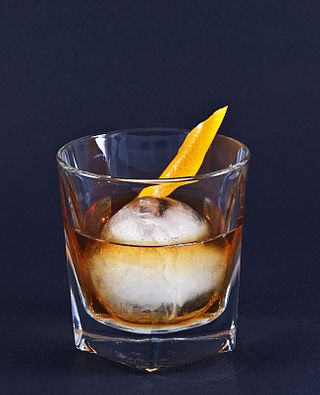
The old fashioned is a cocktail made by muddling sugar with bitters and water, adding whiskey or sometimes brandy, and garnishing with an orange slice or zest and a cocktail cherry. It is traditionally served with ice in an old fashioned glass.

A teaspoon (tsp.) is an item of cutlery. It is a small spoon that can be used to stir a cup of tea or coffee, or as a tool for measuring volume. The size of teaspoons ranges from about 2.5 to 7.3 mL. For cooking purposes and dosing of medicine, a teaspoonful is defined as 5 mL, and standard measuring spoons are used.
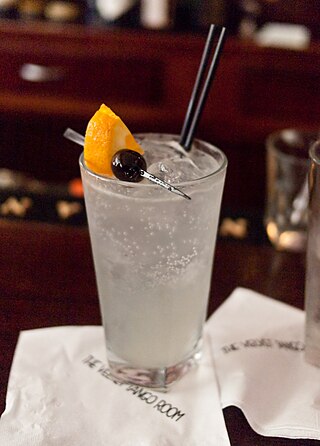
The Tom Collins is a Collins cocktail made from gin, lemon juice, sugar, and carbonated water. First memorialized in writing in 1876 by Jerry Thomas, "the father of American mixology", this "gin and sparkling lemonade" drink is typically served in a Collins glass over ice. A non-alcoholic "Collins mix" mixer is produced, enjoyed by some as a soft drink.

English cuisine encompasses the cooking styles, traditions and recipes associated with England. It has distinctive attributes of its own, but is also very similar to wider British cuisine, partly historically and partly due to the import of ingredients and ideas from the Americas, China, and India during the time of the British Empire and as a result of post-war immigration.
An hors d'oeuvre, appetiser or starter is a small dish served before a meal in European cuisine. Some hors d'oeuvres are served cold, others hot. Hors d'oeuvres may be served at the dinner table as a part of the meal, or they may be served before seating, such as at a reception or cocktail party. Formerly, hors d'oeuvres were also served between courses. There are two types of hors d'oeuvre from service point of view:
- General hors d'oeuvre
- Classical hors d'oeuvre

French 75 is a cocktail made from gin, champagne, lemon juice, and sugar. It is also called a 75 Cocktail, or in French simply a Soixante Quinze.

The martini is a cocktail made with gin and vermouth, and garnished with an olive or a lemon twist. Over the years, the martini has become one of the best-known mixed alcoholic beverages. A popular variation, the vodka martini, uses vodka instead of gin for the cocktail's base spirit.
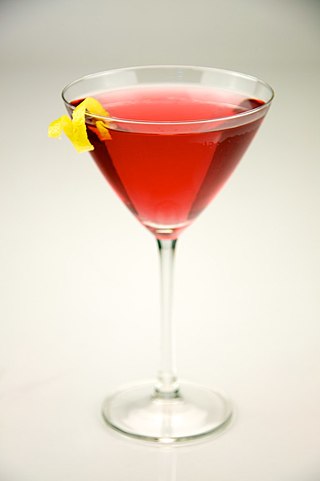
A cosmopolitan, or, informally, a cosmo, is a cocktail made with vodka, Cointreau, cranberry juice, and freshly squeezed or sweetened lime juice.

Jane Grigson was an English cookery writer. In the latter part of the 20th century she was the author of the food column for The Observer and wrote numerous books about European cuisines and traditional British dishes. Her work proved influential in promoting British food.

Various unique terminology is used in bartending.

The Pacific-Union Club is a social club located at 1000 California Street in San Francisco, California, at the top of Nob Hill. It is considered to be the most elite club of the West Coast, and one of the most elite clubs in the United States, along with the Knickerbocker Club in New York, the Metropolitan Club in Washington D.C., and the Somerset Club in Boston.
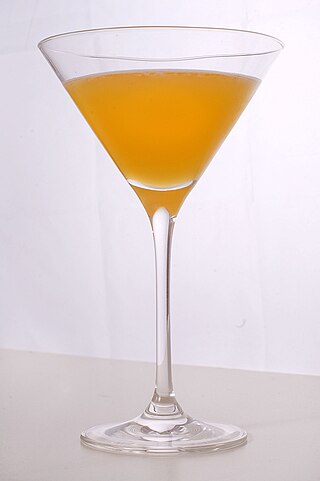
The Bronx is a cocktail. It is essentially a Perfect Martini with orange juice added. It was ranked number three in "The World's 10 Most Famous Cocktails in 1934" behind the Martini (#1) and the Manhattan (#2). In the 1934 movie "The Thin Man", the lead actor compared the methods for shaking the Manhattan, the Bronx and the Martini.

A bijou is a mixed alcoholic drink composed of gin, vermouth, and chartreuse. This cocktail was invented by Harry Johnson, "the father of professional bartending", who called it bijou because it combined the colors of three jewels: gin for diamond, vermouth for ruby, and chartreuse for emerald. An original-style bijou is made stirred with ice as Johnson's 1900 New and Improved Bartender Manual states "mix well with a spoon and serve." This recipe is also one of the oldest in the manual, dating back to the 1890s.
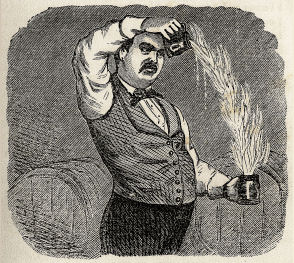
Jeremiah P. Thomas was an American bartender who owned and operated saloons in New York City. Because of his pioneering work in popularizing cocktails across the United States as well, he is considered "the father of American mixology". In addition to writing the seminal work on cocktails, Bar-Tender's Guide, Thomas displayed creativity and showmanship while preparing drinks and established the image of the bartender as a creative professional. As such, he was often nicknamed "Professor" Jerry Thomas.

Death in the Afternoon, also called the Hemingway or the Hemingway Champagne, is a cocktail made up of absinthe and Champagne, invented by Ernest Hemingway. The cocktail shares a name with Hemingway's 1932 book Death in the Afternoon, and the recipe was published in So Red the Nose, or Breath in the Afternoon, a 1935 cocktail book with contributions from famous authors. Hemingway's original instructions were:
"Pour one jigger absinthe into a Champagne glass. Add iced Champagne until it attains the proper opalescent milkiness. Drink three to five of these slowly."

Louis Szathmary was a Hungarian-American chef, writer, and public personality. A pioneering force in the food service profession, he is best known for heading the Chicago restaurant The Bakery and writing the New York Times bestseller The Chef's Secret Cookbook. Szathmary's involvement with the early frozen food industry, his numerous cookbooks and articles and his persona established him as an icon in the culinary arts industry.

Anchovy paste is a fish paste food product prepared using anchovies as a primary ingredient. It is used as a condiment and as an ingredient in various dishes, such as Scotch woodcock, and is a mass-produced product. It has been used for centuries to provide flavor to foods and as a source of nutrients, and it is a part of the cuisines of Great Britain, Italy, the Philippines and Vietnam. It is a major export product of Morocco.

The doctor cocktail is a pre-prohibition era cocktail that traces in drink guides to as far back as 1917, when it appeared in Hugo R. Ensslin's Recipes for Mixed Drinks. As originally described the cocktail called simply for Swedish Punsch mixed with lime juice.
References
- 1 2 3 4 5 Epicurious [ permanent dead link ]
- ↑ Fichtner, Margaria (March 18, 2002). "Gentleman's Gentleman". Miami Herald.
- ↑ Bakers in the 1900 US Census in Zellwood, Florida
- ↑ World War I draft registration.
- ↑ Baker, Charles H. Jr., The Gentleman's Companion, Volume II.
- ↑ Dunlop, Beth, Miami: Trends and Traditions; New York: The Montacelli Press, 1996, page 104
- ↑ "Latin-American Food". Los Angeles Times . July 11, 1951.
- ↑ John J. Poister; Wine Lover's Drink Book; page 71
- 1 2 "Florida Flatwoods". Time. April 22, 1946. Archived from the original on December 2, 2007. Retrieved 2007-05-21.
- ↑ Hedonista
- ↑ Social Security Death Index.[ clarification needed ]
- ↑ Florida Death Index.[ clarification needed ]
- ↑ Worldcat
- ↑ Tinker, Edward Larocque (August 25, 1940). "New editions, fine or otherwise". The New York Times .
- ↑ The New York Public Library
- ↑ "The Eclectic Epicure". The Washington Post . November 19, 1939.
- ↑ Poore, Charles (April 20, 1946). "Books of the Times; Powerful Nemesis Is Abandoned Time Is Early in This Century". The New York Times.
- ↑ ASIN B000OEHEPQ
- ↑ ASIN B000KTPRPO
- ↑ "Review". Virginia Quarterly Review. August 1982. p. 138.; ASIN B000E0XQZW
- ↑ Charles h. Baker, Jr (November 2000). Knife, Fork and Spoon: Eating Around the World. ISBN 1-58667-049-2.
- ↑ ASIN B000FD7KLO
- ↑ Claiborne, Craig (August 2, 1959). "Recipe for Pleasure; The Esquire Culinary Companion". The New York Times Book Review.
- ↑ OCLC 588195